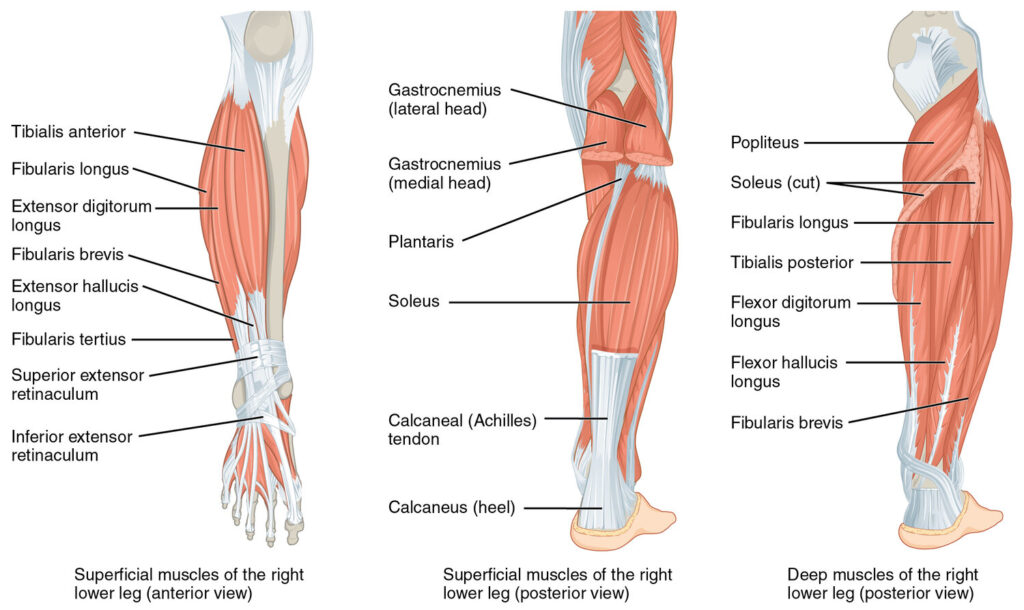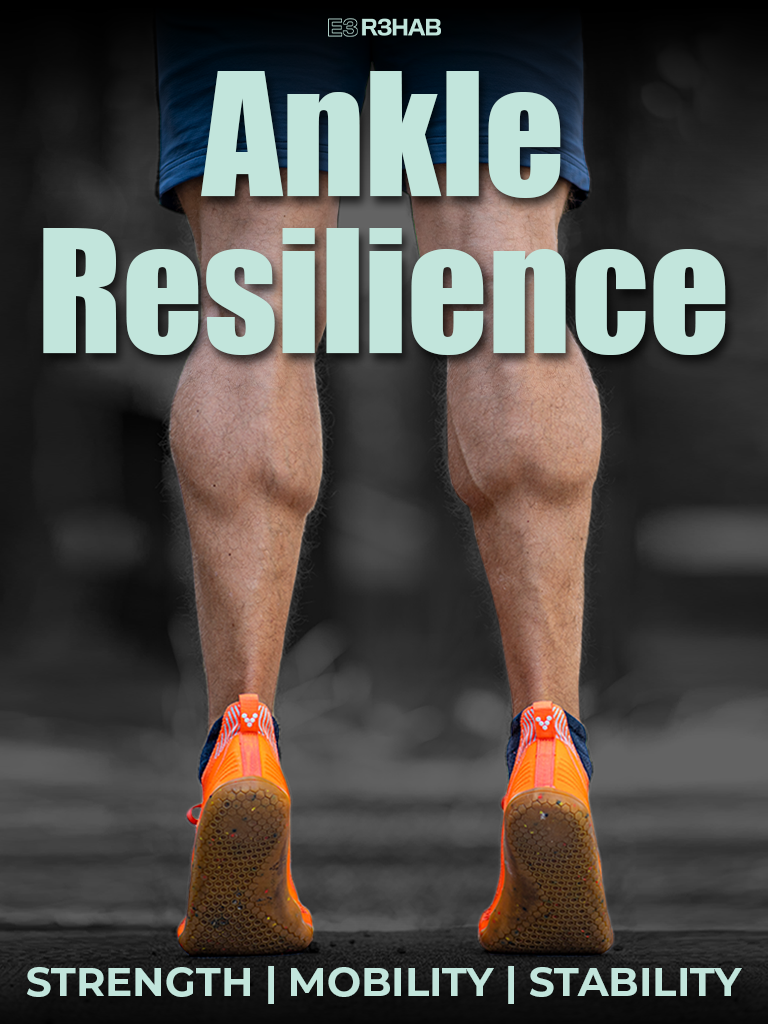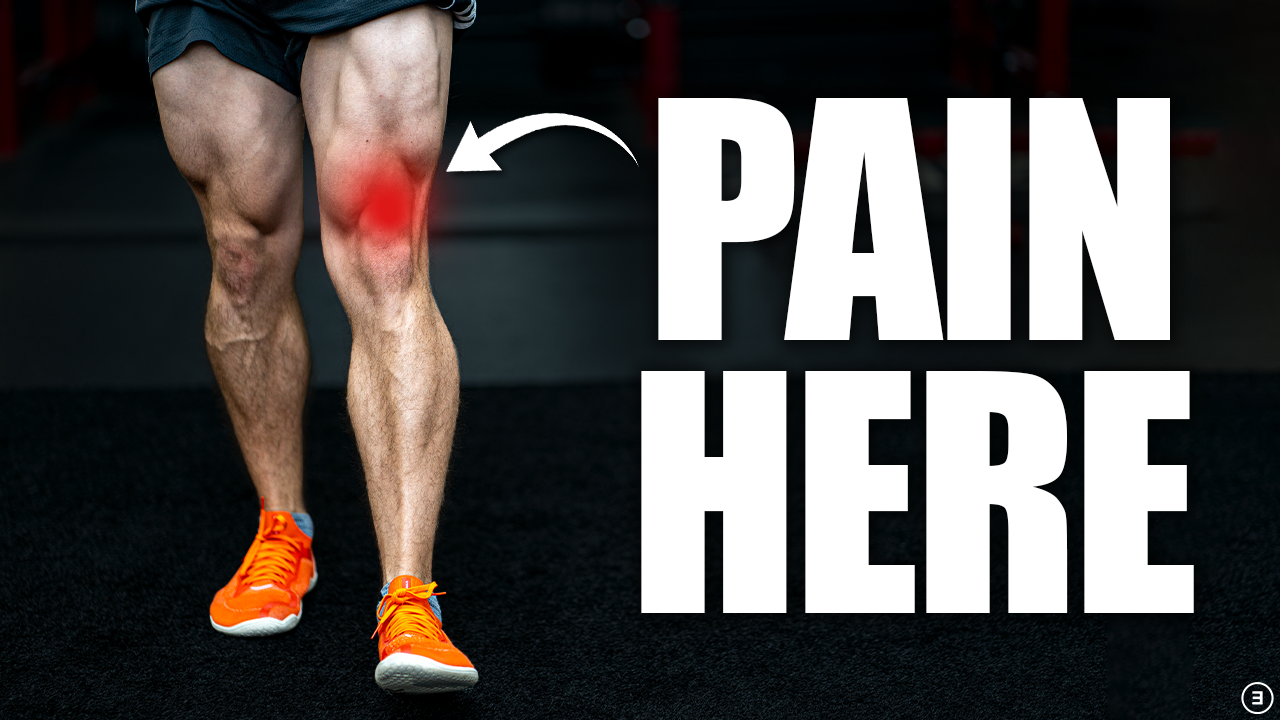The purpose of this blog is to discuss the anatomy and function of the triceps surae (gastrocnemius and soleus), 6 reasons why you should be performing calf raises, and how to execute and program them into your routine. Calf raises and heel raises will be used interchangeably.
Looking to improve the strength, range of motion, and stability of your ankles to enhance your function and performance? Check out our Ankle Resilience program!
Anatomy & Function
The lower leg, or shank, consists of 4 different compartments of muscles:
- Anterior Compartment – Tibialis Anterior, Extensor Hallucis Longus, Extensor Digitorum Longus, Peroneus Tertius
- Lateral Compartment – Peroneus Longus, Peroneus Brevis
- Deep Posterior Compartment – Tibialis Posterior, Flexor Digitorum Longus, Flexor Hallucis Longus, Popliteus
- Superficial Posterior Compartment – Gastrocnemius (Medial and Lateral Heads), Soleus, Plantaris
Aside from the popliteus, heel raises will target the muscles of the lateral and posterior compartments, but this blog will primarily be focusing on the gastrocnemius and soleus (also known as the triceps surae). The gastrocnemius is comprised of two heads, medial and lateral, that attach proximally to the distal aspect of the femur. The soleus, on the other hand, attaches to both the tibia and fibula. Together, these muscles insert onto the calcaneus, or heel, via the Achilles tendon.
The gastrocnemius and soleus are both responsible for plantar flexion and inversion of the ankle in a non-weightbearing position (pointing the foot down and in). In a weightbearing position, this is referred to as a calf, or heel, raise. Since the gastrocnemius crosses the knee joint, it also aides in knee flexion, particularly between 0-15 degrees of knee flexion. Both muscles are vital for ambulation.
Soleus
Before discussing the 6 reasons why you should be performing heel raises, I think it’s important to highlight the size and force producing capabilities of the often forgotten soleus. If we look to research by Albracht et al in 2008 and Ward et al in 2009, we see that the soleus can make up to 60% of the mass and physiological cross sectional area of the calf (just factoring in the soleus and gastrocnemius). Ward and colleagues also write that “muscle architectural values are the best predictors of muscle function” and that the “PCSA is proportional to a muscle’s maximum force-producing capacity.” The soleus might actually be a slight exception to this rule, but Lieber and Frieder also highlight that the soleus is designed for generating high force with small excursion. Overall, the soleus is a beast!
Reason 1 – Achilles Tendinopathy
- Mahieu et al in 2006 reported that “the strength of the plantar flexors was identified as a predictor for an achilles tendon overuse injury, with subjects having a lower plantar flexor strength at greater risk”
- O’Neill et al in 2019 found that individuals with achilles tendinopathy had deficits in plantar flexor strength and endurance on BOTH sides (symptomatic and asymptomatic compared to controls) with “weakness of the soleus appearing to be responsible for the majority of the deficits”
- Willy and Paquette in 2019 highlight that “achilles tendinopathy is the most common running related injury experienced by the Master runner” and many subsequent consequences of aging and changes in training as it relates to plantar flexor strength and Achilles tendon stiffness
- Beyer and colleagues in 2015 demonstrated that calf raises done eccentrically, or heavy and slow, can be an effective means for treating achilles tendinopathy
No matter how you look at it, you should be strengthening your plantar flexors if you’re at risk for developing Achilles tendinopathy or rehabilitating the issue.
Reason 2 – Medial Tibial Stress Syndrome
Also known as shin splints, this is another common issue in runners. Traditionally thought to be related to the tibialis posterior, Franklyn and Oakes concluded that “the two main mechanisms of injury appear to be a traction-induced periostitis, where the cause is likely to be the soleus and/or the FDL, and microtrauma comprising of oedema and microcracks in the cortical bone which result in debonding of the osteons and subcutaneous periostitis on the surface of the tibia.” Admittedly, I think it’s a diagnosis that’s still not well understood. However, one of the leading researchers on the topic, Marinus Winters, postulates that “a combination of graded tibial loading exercises and ankle plantar strengthening exercises may, therefore, be the best strategy for athletes with MTSS.”
Reason 3 – Anterior Cruciate Ligament
Most people know that the hamstrings can be protective of the ACL due to the posterior pull that this muscle group has on the tibia during dynamic movements (referred to as an ACL agonist), but Elias et al in 2003 and Mokhtarzadeh et al in 2013 demonstrated that the soleus can also be protective of the ACL even though it doesn’t cross knee!
Reason 4 – Running Performance
In many circles, running is all about the glutes! Buuut it should probably be all about the calves! Especially the soleus! Dorn et al in 2012 and Schache and colleagues in 2014 demonstrated that for speeds up to 7 m/s, or a 3.8 minute/mile, the ankle plantar flexors are one of the primary drivers for forcefully pushing into the ground, resulting in a longer stride length, which equates to faster running speeds. And musculotendon forces get up to 8 times bodyweight for the soleus during the stance phase of running!
Reason 5 – Ankle Dorsiflexion
Now, there’s nothing wrong with performing various mobility drills to improve ankle dorsiflexion. However, those exercises usually only influence one biomotor ability – flexibility, or range of motion. If we instead perform heel raises at a high intensity through a large range of motion, we are now improving mobility while also enhancing other capacities such as strength, endurance, tendon stiffness, etc. You get a lot more bang for your buck in the same amount of time.
Reason 6 – Aesthetics
Strong calves just look good and while genetics are often blamed for their structure or potential for change, they’re a muscle group that can be trained just like any other!
Execution
If all of this information sways you to start performing heel raises, there’s several boxes you need to check off!
- Intensity – Exercises NEED to be heavy and hard. Aim for 6-12 repetitions. Not even if you’re a runner, but especially if you’re a runner to improve qualities such as tendon stiffness (must be 70% of 1RM or greater). This is also a great range for hypertrophy.
- Tempo, or speed of the movement – Slow and controlled! Don’t bounce the reps. Think about 3 seconds up and 3 seconds down for EVERY repetition.
- Range of Motion – Get a full stretch at the bottom and a peak contraction at the top. It is preferable if you use a deficit such as a step, stair, or some other object.
- Contraction Type – Highlighted by Bohm et al in 2015, it doesn’t necessarily matter. It just needs to follow the other principles. You DON’T have to do eccentrics only, but it is one option if that’s what you prefer.
- Proximity to Failure – If you’re working really hard in that 6-12 rep range, you should either hit failure or be roughly 1-3 reps shy of failure. It NEEDS to be hard!
- Rest Times – 2 minute rests between sets MINIMUM. Take your time, do it right, and it’ll pay off in the long run.
Programming Heel Raises
Without a doubt, you should be utilizing knee straight and knee bent variations. A study by Landin et al in 2015 demonstrated that the gastrocnemius is at a less of a mechanical advantage when the knee is flexed beyond 60 degrees. Now, either option will target both muscles, but we might be able to achieve preferential activation of the soleus with knee bent variations.
If you’re going to perform a knee bent variation, it is preferable that you are seated so that your quads are not the limiting muscle group and so that you can provide overload to your calves. An example would be a wall sit on the balls of your feet vs a seated heel raise using a machine. There are a lot of options here for the gym and at home – smith machine, dumbbells on your thighs, leg press, steps, and the list goes on. You just have to find options available to you that work well for you.
In terms of actual programming, I like to keep it very simple if it’s your first time including heel raises into your routine. Two times per week! On one day of the week, perform 3 sets of 6-12 repetitions using a knee straight variation. On a different day of the week with at least 1-2 days of rest in between, perform another 3 sets of 6-12 repetitions using a knee bent variation. That’s it! Over time, add another set or two per day, and eventually, if needed, you can work up to 12-15 sets over the course of 3 days with a day of rest in between.
Final Thoughts
Calf training is usually an afterthought for most people, but hopefully this information makes you reconsider your approach.
Don’t forget to check out our Ankle Resilience Program!
Want to learn more? Check out some of our other similar blogs:
Chronic Ankle Instability, Shin Splints, Strength Training for Runners
Thanks for reading. Check out the video and please leave any questions or comments below.








